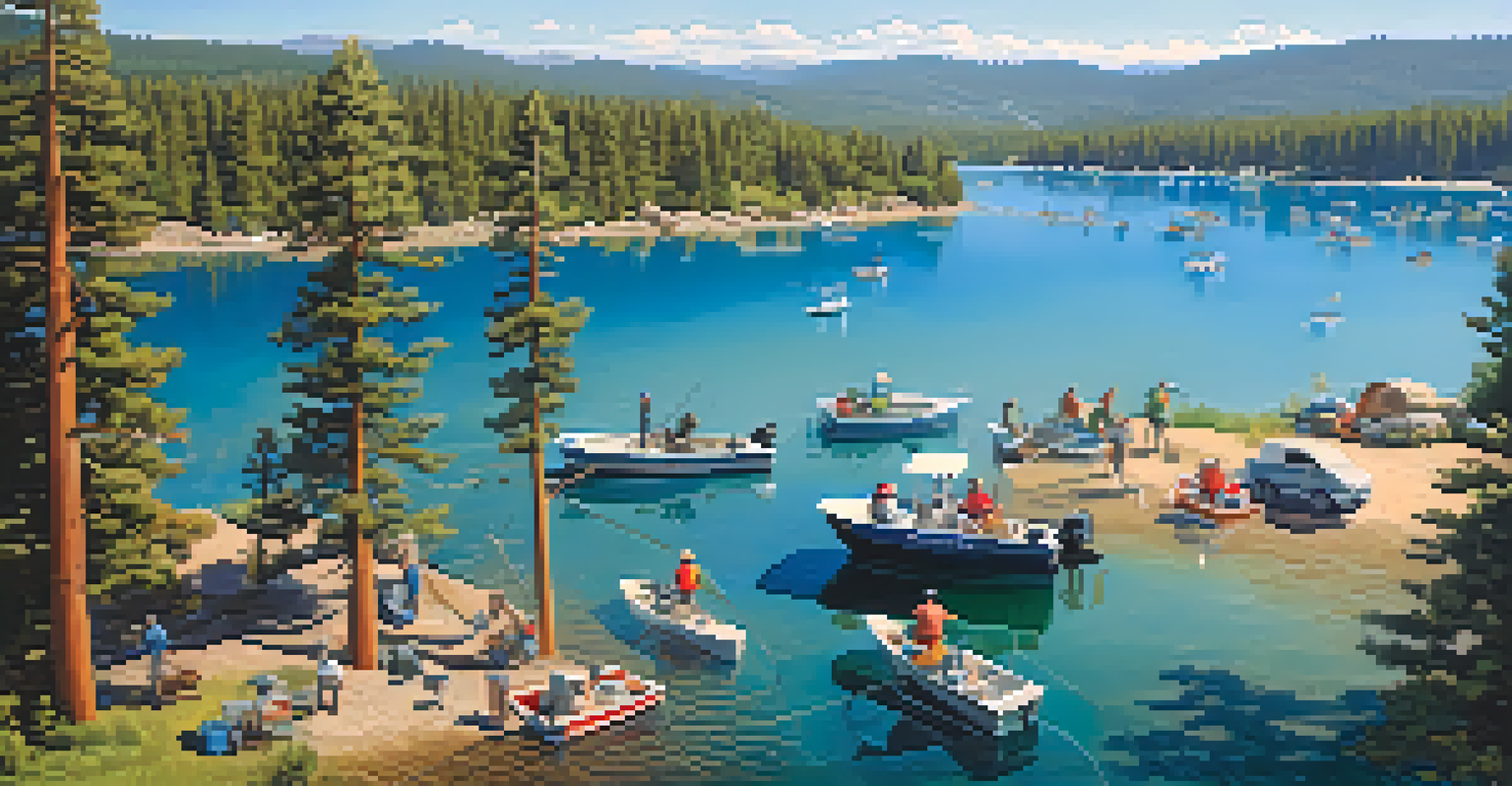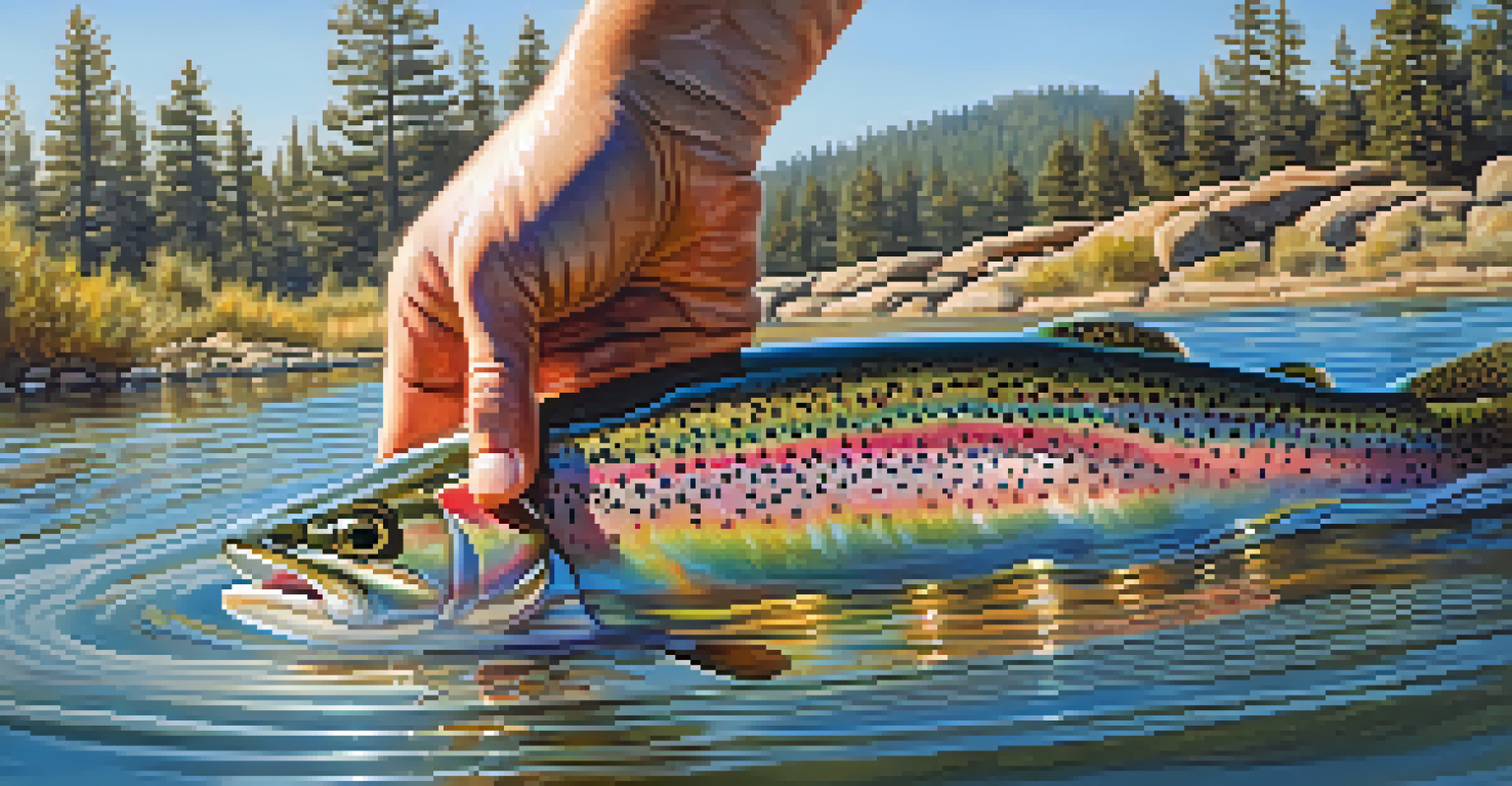Fishing Regulations and Licenses for Big Bear Lake

Understanding Fishing Regulations at Big Bear Lake
Fishing regulations at Big Bear Lake are designed to protect the local ecosystem while ensuring an enjoyable experience for anglers. These rules specify what species can be caught, size limits, and the seasons when fishing is allowed. It's important to familiarize yourself with these regulations to avoid fines and to contribute to sustainable fishing practices.
Fishing is not an escape from life, but often a deeper immersion into it.
For instance, some species may have specific catch limits, while others might be catch-and-release only. These regulations help maintain fish populations, ensuring that future generations can enjoy fishing in this beautiful area. Be sure to check local announcements or the California Department of Fish and Wildlife website for any updates or changes.
In addition to species-specific rules, there are also general regulations concerning fishing methods and gear. Knowing what is permitted can enhance your fishing experience, making it both legal and enjoyable. Always carry a copy of the regulations with you or have them accessible on your smartphone as a handy reference.
Types of Fishing Licenses Required
Before casting your line at Big Bear Lake, you need to obtain the appropriate fishing license. In California, there are several types of licenses available, including a general fishing license and a one-day license for those who only plan to fish occasionally. Understanding which license fits your needs is crucial to enjoying a hassle-free fishing trip.

For residents and non-residents, the prices may differ, and special licenses can be acquired for fishing in certain areas or for specific types of fish. For example, if you’re planning to fish for trout, additional stamps or permits may be required. Always check the latest requirements before your visit to ensure compliance.
Know Fishing Regulations
Familiarizing yourself with fishing regulations at Big Bear Lake is crucial for sustainable practices and avoiding fines.
Licenses can be purchased online through the California Department of Fish and Wildlife website, at local sporting goods stores, or at designated kiosks. Each license is valid for a year, so if you fish regularly, it might be worth investing in an annual license to save money in the long run.
Where to Buy Fishing Licenses for Big Bear Lake
Purchasing a fishing license for Big Bear Lake is a straightforward process, with several options available to you. The California Department of Fish and Wildlife offers online purchasing, which is convenient and can be done from the comfort of your own home. Simply visit their website, choose the appropriate license, and follow the prompts to complete your purchase.
The fishing was good; it was the catching that was bad.
If you prefer to buy in person, many local sporting goods stores and bait shops around Big Bear Lake sell fishing licenses. This can also be a great opportunity to ask the staff for advice on the best fishing spots and tackle to use in the area. They often have valuable insights that can enhance your fishing experience.
Additionally, some local marinas and visitor centers may offer fishing licenses for sale. Make sure to have your identification and any necessary information ready to streamline the purchasing process, ensuring you can hit the water without delays.
Fishing Seasons and Best Times to Fish
Understanding the fishing seasons at Big Bear Lake is key to making the most of your fishing trips. Generally, the fishing season runs from the last Saturday in April through the end of November, but specific dates may vary. Knowing when to go can greatly impact your success on the water, as fish are more active during certain times of the year.
Early morning and late evening are often considered the best times to fish, as many fish species are more active during these cooler parts of the day. Additionally, weather conditions and moon phases can play a significant role in fish behavior. Keeping an eye on local forecasts can help you plan your trips for optimal fishing conditions.
Choose the Right License
Obtaining the appropriate fishing license is essential for a hassle-free experience at Big Bear Lake.
Always remember to check for any seasonal restrictions or special events, such as trout plants or fishing derbies, that may affect fishing opportunities. Engaging with local fishing communities online can also provide valuable tips on the current fishing conditions at Big Bear Lake.
Popular Fish Species at Big Bear Lake
Big Bear Lake is home to a diverse range of fish species, making it a popular destination for anglers. Some of the most sought-after species include trout, bass, and catfish. Each species presents unique challenges and rewards, so understanding their habits can improve your chances of a successful catch.
Trout, particularly rainbow and brown trout, are abundant in the lake and are often targeted by anglers. Knowing the best bait and lures for these fish can make a significant difference. In contrast, bass fishing may require different techniques and gear, such as using artificial lures or live bait to attract these feisty fighters.
Catfish are also popular, especially during warmer months when they are more active. Many anglers enjoy the thrill of night fishing for catfish, as they tend to feed more aggressively after dark. Familiarizing yourself with the characteristics of each species will help you tailor your fishing strategy accordingly.
Catch and Release Practices at Big Bear Lake
Catch and release fishing is a practice that promotes conservation and helps maintain the fish population at Big Bear Lake. By returning fish to the water after catching them, anglers can ensure that future generations can enjoy the same experience. It's important to follow proper techniques to minimize harm to the fish during the release process.
When practicing catch and release, use barbless hooks whenever possible, as they cause less injury to the fish. Handle the fish gently and wet your hands before touching them to avoid damaging their protective slime layer. Additionally, using a net can help reduce stress on the fish and increase their chances of survival once released.
Best Times to Fish
Understanding fishing seasons and optimal times, like early mornings and late evenings, can significantly enhance your success.
Educating fellow anglers about the benefits of catch and release can foster a community focused on sustainability. Sharing tips and best practices can encourage others to adopt this approach, ultimately contributing to a healthier ecosystem at Big Bear Lake.
Staying Informed About Fishing Regulations
Staying informed about fishing regulations is essential for every angler visiting Big Bear Lake. Regulations can change frequently due to environmental factors, fish population assessments, or local management decisions. Keeping up to date ensures that you are fishing responsibly and legally, preventing any unintended violations.
One effective way to stay informed is by regularly checking the California Department of Fish and Wildlife website for updates on regulations and fish stocking schedules. Additionally, consider subscribing to local fishing newsletters or joining online forums where fellow anglers share information and experiences.

Engagement with the local fishing community can also provide insights into best practices and recent changes in regulations. By being proactive and informed, you contribute to the preservation of Big Bear Lake's fishing resources while enhancing your own experience.